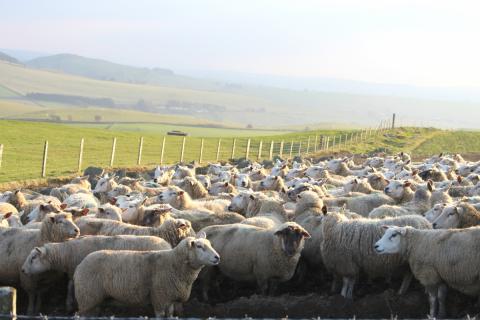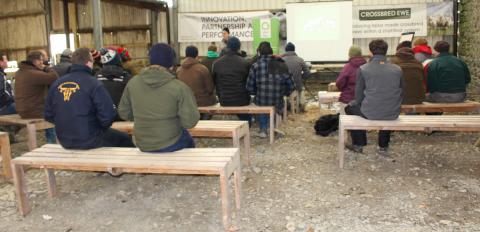ENSURING ewes are in the right condition throughout the year and feeding them efficiently in order to maintain performance can have a significant impact on profitability and productivity. Maximising the use of forage can help drive down costs and offer an efficient production system for sheep enterprises.
Maintaining target Body Condition Score (BCS) throughout the year is one of the main factors that enable the ewe flock to perform at their maximum potential. Feeding ewes appropriately at specific times can help correct BCS and influence performance. Speaking at a Farming Connect Innovation Site Open Day at Innovis, Mynydd Gorddu, Bont Goch, Aberystwyth, vet and sheep production consultant Trevor Cook outlined when feeding should be tailored to meet the production needs of the ewe.
“The condition score of a ewe has a big influence on its productivity. Six weeks before mating is a good time to lift the BCS of light ewes, then 10 days before tupping begins feed her well and the impact on ovulation rate is massive. Make sure condition is not lost in the 35 days before lambing as this will influence the amount of live lambs they produce as well as colostrum and milk production.”
Scanning time is a good opportunity to condition score ewes as they are being handled and allows leaner animals to be separated in order to improve their BCS.
“Scanning is an excellent opportunity to get some condition on them,” added Mr Cook. “To lift one condition score needs 30kg DM and costs 30p, so the total cost is 10p/kg DM. Rescuing light ewes is therefore a very profitable use of feed.”
When a ewe hits peak lactation in the three to four weeks after lambing she will have a high food demand and if forage intakes can be maximised during this time, it will impact on production costs.
“A ewe can eat up to 5% of her bodyweight at peak lactation, but this is something you can time and plan for. Grazed pasture is the cheapest feed source available and learning to use it efficiently is a very positive way of increasing profitability.”
At Mynydd Gorddu, efficient production off grassland is the aim of Innovis’ main nucleus flock of 1,200 ewes and 400 ewe lambs which are wintered and lamb outdoors on a forage-based system. The sheep are on a rotational grazing system for a month pre-tupping to achieve a BCS of 3-3.5 before being set stocked for one month over mating. From late December onwards ewes and ewe lambs are split into three groups and strip graze 30 to 35 acres of swedes. After scanning, single bearing ewes are moved to grass buffer areas with silage until a week pre-lambing, while multiple bearing ewes are kept on the swedes until a month before lambing. Multiples are then transferred to rotational grazing of high quality leys with target covers of 1,600-1,800kg DM/ha, supplemented with Undegradable Dietary Protein blocks.
“We condition score regularly and move sheep between groups if needed. We know that by doing that we
will get them going into the lambing fields at BCS 3-3.5 and our work is done,” said Innovis CEO Dewi Jones.
A week pre-lambing, ewes are set stocked on the lambing ground at 10 per acre with 1,800kg DM/ha. The sheep lamb unassisted before being moved back into the grazing rotation with lambs at foot after four weeks on pastures at 8cm to 12cm (2,200kg to 2,700kg DM/ha). Post-weaning at no later than 12 weeks, ewes are mobbed into large groups to clear up paddocks in preparation for autumn production.


